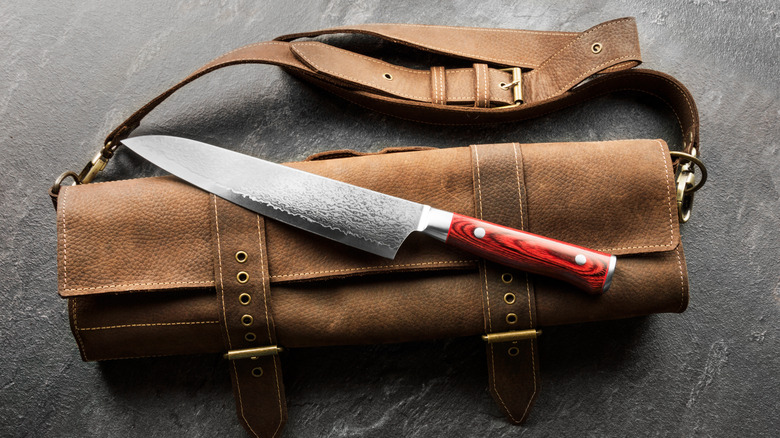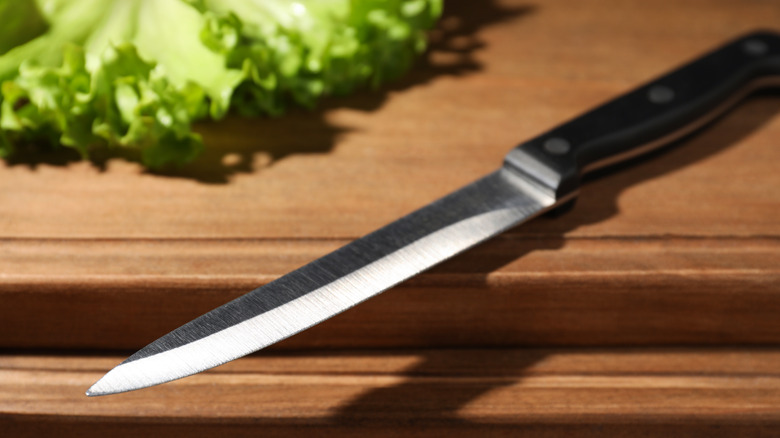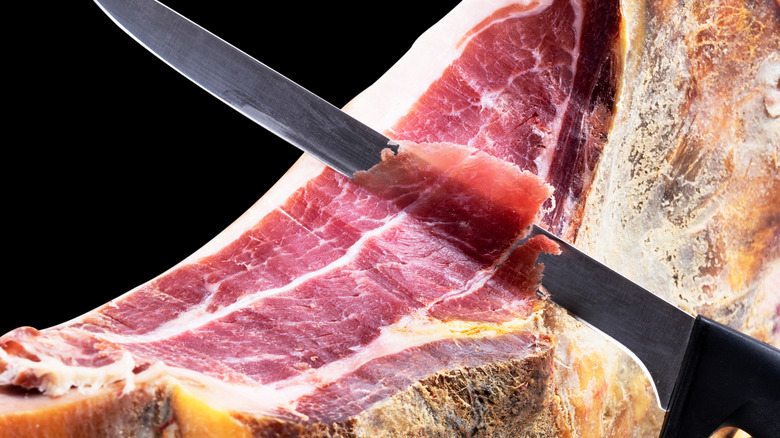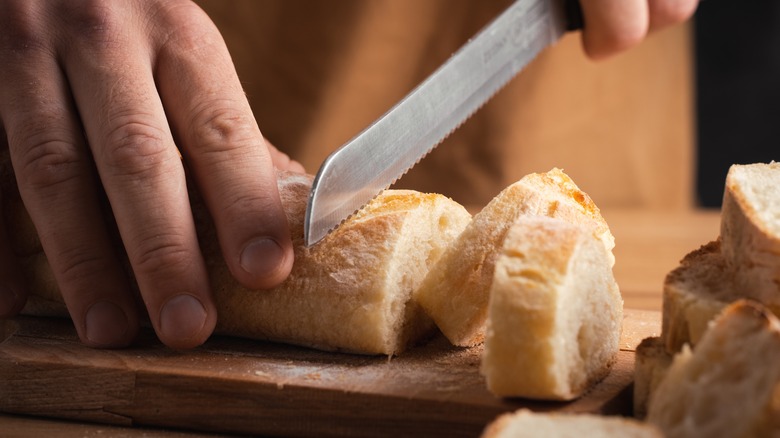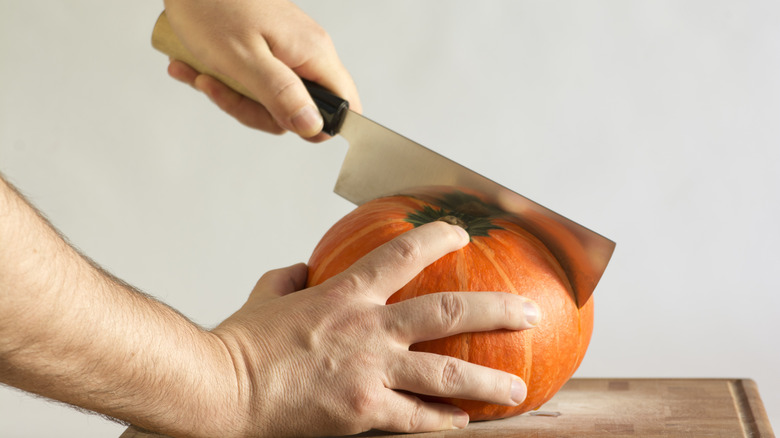The 5 Knives Alton Brown Says Are Most Important For You To Own
Celebrity chef Alton Brown might be best known for the off-beat and quirky cooking tips (like making Rice Krispie treats in a cereal box) and hacks that he presented to the public over 16 seasons of his series "Good Eats" (via Food Network). That doesn't mean he's not a fan of a good old-fashioned kitchen tool like a good set of knives, though. And who can blame him? Because restaurants expect professional chefs to supply their own knife sets, having a complete set can also seem like a mark of credibility to home chefs.
According to Kitchn, you don't need a whole fancy set of knives. For most of those sets, you'll be paying for way more than you need, and you're better off with a small set of quality knives instead. Brown claims to be obsessed with knives and says he owns tons of them. Still, he says five are essential, and he recently posted a video sharing his picks. There are also some honorable mentions, like a good pair of kitchen shears and a beloved butcher's cleaver, but here are Brown's top five essential knives.
Chef's Knife
As many know, the chef's knife is essential in any kitchen. Brown says that if you can only have one knife, it should be this one. Chef's knives are the ultimate multi-purpose tool, ranging from 8 inches to a whole foot long, and are perfect for chopping, slicing, and dicing. This blade is one of the most popular out there for a good reason.
Brown says that while the length of the blade may intimidate some, it serves a purpose. The long edge allows you to cut with one end and pivot on the tip when chopping. This is helped along by the curve of the blade, which sets it apart from straight-bladed Santoku knives (Made In). The New York Times says that this rocking and chopping motion is one of the most essential for any aspiring chef, and the standard chef's knife makes it feel easy.
Utility Knife
The utility knife looks similar to the chef's knife with its tapered point and slightly curved blade, but it is significantly smaller. According to America's Test Kitchen, the utility knife typically has a 5 to 6-inch blade. In terms of size, it falls just between the smaller paring knife and the much larger chef's knife, which makes it a versatile option to keep on hand for quick slices and more precise cuts.
Brown says that he prefers a utility knife to the paring knife, though he uses it for many of the same needs by moving his grip up the utility knife's blade for more control. Bustle notes that utility knives can be found with serrated blades for those seeking a smaller-style serrated knife. Given their nickname of "sandwich knives," many could find a serrated version gets more usage in the kitchen than a straight-edged counterpart (via Kamikoto).
Boning Knife
Boning knives are exactly what they sound like; a tool meant to help cut around bones in meat and fish. Spruce Eats points out that this is not one of the most popular knives for many home cooks. Boneless meat is readily available at most grocery stores, and for some, the work of deboning can seem like too much trouble. However, if you're a hunter or someone who prefers to break down their own meat, this blade is essential.
These blades are thin and light. They can range in length from 5 inches up to 7, which is the length recommended by the knife company Kamikoto. Their most distinctive feature is their flexibility. Spruce Eats points out that boning knives are typically less flexible than similar-looking filet knives. There are also more stiff options available for those that are regularly breaking down animals with tougher joints and large bones. According to Field & Stream, boning knives are also great for reducing waste; the thin, flexible blades allow for greater precision and will leave less meat on the bone than a chef's knife. They are also helpful for scraping small bits of meat off of bone for dishes like a crown roast.
Serrated Knife
If you've ever tried to hack your way through a loaf of bread with a chef's knife, then you know just how valuable a good serrated knife can be. According to Everyday Carry, the serrations in the blade of a knife are great because they act like small teeth that grip into whatever you're cutting as the edge drags across the surface. This gives you more grip for cutting into hard or uneven surfaces. It also makes it easier to cut into delicate foods that will fall apart under sustained pressure. That means they're perfect for cutting through hard-crusted bread but are also delicate enough to slice through the softest loaf of Wonder Bread, as noted by Serious Eats.
Brown recommends these knives for cutting through bread or cleaning up cakes. Chef Thomas Keller also recommends using them to cut through tomatoes without turning them into a paste. As HuffPost points out, if you're someone who doesn't regularly sharpen your knives, then you know the pain of trying to hack away at a tomato. This is probably one of the more specialized options from Brown's picks, but just because it isn't as versatile doesn't mean you should go without a good serrated knife.
Nakiri Knife
Likely the least well-known of Brown's recommendations is the nakiri, or vegetable, knife. According to Made In, the nakiri knife is a classic Japanese knife style with a long, straight blade. Their rectangular, symmetrical shape makes them almost resemble small butcher cleavers in a way. Kamikoto says that, as the name suggests, these blades are designed to help easily cut through vegetables. Of course, you can do this with your chef's knife too. So, what makes a nakiri knife so special?
Knife Wear points out that when cutting large batches of vegetables for a dish, it can be easy to make incomplete cuts that don't entirely separate each piece of whatever you're cutting. However, the nakiri's flat blade does a far better job of making complete contact with the board and tearing through a vegetable's tough skin. It does take some getting used to, though, as the blade doesn't rock and pivot like the chef's knife. Instead, it's much more appropriate to use a sliding action. This might not come easily at first, but once you learn the motion, this might just be your favorite prep knife.

